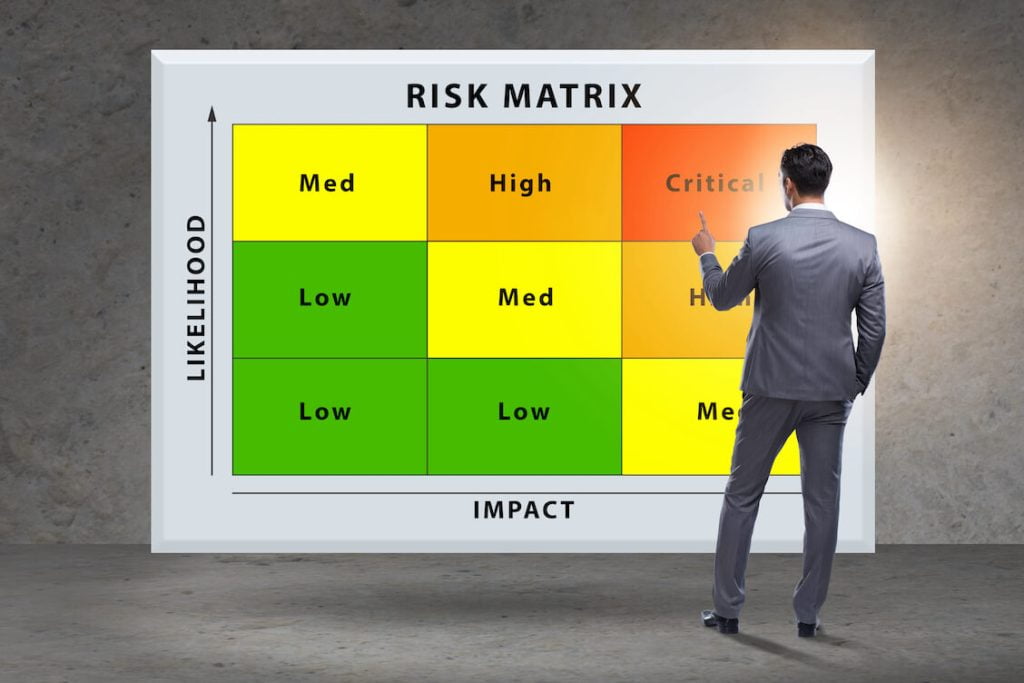
As a freelancer, you’re used to navigating a world of uncertainty. You never quite know what projects will come your way, or whether your income will be steady from one month to the next. But while some level of risk is inevitable, there are steps you can take to manage it more effectively. One such tool is the risk matrix, a simple yet powerful framework for identifying and prioritizing potential risks in your work.
By using a risk matrix, you can better understand the potential impact of different risks, make informed decisions about how to mitigate them, and ultimately reduce the likelihood of unexpected setbacks. In this article, we’ll explore what a risk matrix is, how it works, and why it’s particularly valuable for freelancers. Whether you’re a seasoned freelancer or just starting out, this article will provide you with practical insights to help you stay on top of your game.
What Is a Risk Matrix in Project Management?
A risk matrix is a project management tool used to evaluate and prioritize potential risks based on their likelihood and potential impact on project objectives. It is a visual representation of a table that maps risks according to their severity and probability, allowing project managers to quickly identify the most significant risks to their project.
A typical risk matrix includes two axes:
- the likelihood of the risk occurring
- and the impact it would have on the project.
The likelihood axis usually ranges from low to high, while the impact axis can be categorized based on the degree of harm or disruption that the risk poses to the project’s goals, such as financial loss, delays, or damage to reputation.
Once the potential dangers have been identified and mapped on the matrix, they can be categorized into different levels based on their location on the matrix. High-risk items that have a high likelihood of occurring and significant impact on the project are usually given the highest priority for mitigation and management.
The risk matrix is a valuable tool in project management because it allows project managers to prioritize risks and allocate resources more effectively. By focusing on the most significant risks, project managers can reduce the likelihood of project failure and increase the chances of success. Furthermore, the risk matrix can help project teams to proactively plan for problems and develop contingency plans, which can mitigate the negative impact of risks on the project.
How to Create a Risk Matrix Template?
Creating a risk matrix template is a simple process that involves a few key steps. Here’s how to create a basic risk matrix template:
Step One: Determine the Scope And Objectives of the Risk Matrix
Before you create a risk matrix, it’s important to define the scope and objectives of the matrix. Identify the project or process that the matrix will be used for, and determine the specific obstacles that you want to assess.
Step Two: Choose the risk matrix format
There are different types of risk matrix formats, including 3×3, 4×4, or 5×5 matrices. Choose the format that best suits your needs, based on the level of complexity of your project and the number of obstacles you want to assess.
Step Three: Define the Likelihood And Impact Categories:
Determine the categories for the likelihood and impact axes of the matrix. For example, likelihood categories could include “unlikely”, “possible”, and “likely”, while impact categories could include “low”, “medium”, and “high”.
For instance, in a five-by-five matrix there are five levels of severity to assess potential risks:
- Negligible (1): Risks that would have minimal consequences if they were to occur.
- Minor (2): Risks that could be easily managed and have manageable consequences.
- Moderate (3): Risks that would take some time and effort to mitigate due to their moderate consequences.
- Major (4): Risks that would have significant consequences, potentially causing long-term damage.
- Catastrophic (5): Risks that would result in severe and detrimental consequences that may be difficult to recover from.
There are also five levels of likelihood:
- Very likely (5): Risks that are almost certain to occur at some point in time.
- Probable (4): Risks that have a high chance of occurring.
- Possible (3): Risks that have an even chance of occurring or not occurring.
- Not likely (2): Risks that have a low chance of occurring.
- Very unlikely (1): Risks that have a remote chance of occurring.
Step Four: Populate the Matrix
Once you have defined the categories, populate the matrix with the risks you want to assess. Identify the likelihood and impact of each risk and map it onto the matrix.
Step Five: Assign Risk Levels
Based on the location of each risk on the matrix, assign a level to each. For example, high-risk items might be those with a high likelihood of occurring and a high impact on the project, while low-risk items might be those with a low likelihood of occurring and a low impact on the project.
A risk assessment typically categorizes risks into three levels of severity:
- Low (1-6): Risks in this category are unlikely to occur and, if they do, they will have minimal consequences for the project or company. These can be labeled as low priority in the risk management plan.
- Medium (7-12): Risks in this category can cause disruptions or hiccups to the project, but with proactive risk management planning, they can be mitigated effectively. While not the highest priority, medium-risk events should not be ignored.
- High (13-25): Risks in this category are likely to occur and have significant consequences that can potentially derail the project. Keeping high-risk events top of mind during project planning is essential to minimize their impact. High-risk events should be the most important aspect of the risk management plan.
Step Six: Develop Mitigation Strategies
Based on the these levels, develop mitigation strategies for each risk. This may include contingency plans, transfer strategies, or acceptance strategies.
Step Seven: Update the Matrix Regularly
A risk matrix should be a living document that is updated regularly. As new obstacles emerge, add them to the matrix and reassess the likelihood and impact of existing risks.
By following these steps, you can create a risk matrix template that helps you identify, prioritize, and manage potential risks in your projects or processes.
Example of a Risk Matrix

Get your free Risk Matrix Template here.
What Are the Benefits of the Risk Assessment Matrix for Freelancers?
As a freelancer, you are responsible for managing multiple projects and clients simultaneously, often with limited resources and support. This makes it critical for you to identify and prioritize potential risks to your work and mitigate them as early as possible. Here are some of the benefits of using a risk assessment matrix as a freelancer:
- Identifying potential risks: A risk assessment matrix allows you to systematically identify and categorize potential risks associated with your work, whether they are related to project delivery, client communication, or financial management.
- Prioritizing risks: By mapping risks according to their severity and probability, you can quickly identify and prioritize the most significant risks that require immediate attention and mitigation.
- Developing mitigation strategies: Once you have identified the most significant risks, you can develop mitigation strategies that are specific to each risk. This may include contingency plans, risk transfer strategies, or risk acceptance strategies.
- Communicating risks to clients: A risk assessment matrix can help you communicate potential risks to your clients more effectively. By sharing the matrix with your clients, you can provide them with a clear understanding of the risks associated with the project and demonstrate your commitment to managing those risks.
- Managing project timelines: A risk assessment matrix can also help you manage project timelines more effectively. By proactively addressing potential risks, you can reduce the likelihood of delays and disruptions, which can ultimately save you time and money.
What Are the Challenges of the Risk Assessment Matrix for Freelancers?
While the risk assessment matrix is a useful tool for managing risk, freelancers may encounter a number of challenges when using this framework. Some of the challenges of using a risk assessment matrix as a freelancer include:
- Limited resources: Freelancers often have limited resources, including time and money, which can make it difficult to conduct a comprehensive risk assessment and develop effective mitigation strategies.
- Lack of experience: Some freelancers may lack experience in risk management, which can make it challenging to identify potential risks and develop appropriate mitigation strategies.
- Unforeseen risks: Despite careful planning and assessment, unforeseen issues may still arise, making it difficult to effectively manage all potential complications.
- Client communication: While a risk assessment matrix can be a useful tool for communicating potential obstacles to clients, some clients may not understand the terminology or may not appreciate the value of risk management, which can make it challenging to effectively manage possible complications.
- Time constraints: As a freelancer, time is often a valuable commodity, and conducting a comprehensive risk assessment can be time-consuming. Balancing risk assessment with project deadlines can be a challenge. This is why we strongly recommend using a time tracking tool like Traqq to manage your time wisely.
Despite these challenges, using a risk assessment matrix can be an effective way for freelancers to manage risk and ensure the success of their projects. By taking a proactive approach to risk management and using tools like the risk assessment matrix, freelancers can better identify potential risks, develop appropriate mitigation strategies, and ultimately increase their chances of success.
FAQ
How to Use Risk Matrix Results?
After completing a risk matrix assessment, the results can be used in several ways to manage risk effectively.
Firstly, the results can help prioritize risks based on their likelihood and potential impact. High-risk items can be given the highest priority for mitigation, while low-risk items may not require immediate attention.
Secondly, based on the results of the risk matrix, mitigation strategies can be developed for each risk. This may include contingency plans, risk transfer strategies, or risk acceptance strategies.
Thirdly, the results can help allocate resources effectively to manage risks. For example, high-risk items may require additional resources to mitigate, while low-risk items may not require as much attention.
Lastly, regular reviews and updates of the risk matrix can help monitor the effectiveness of risk management strategies and ensure that risks are being managed effectively.
Who Invented the Risk Matrix?
The origins of the risk matrix are unclear, as it has been used by different industries and organizations in various forms for several decades. However, the risk matrix gained popularity in the aerospace industry in the 1970s and 1980s, where it was used to manage risks in aircraft design and maintenance.
One of the earliest documented uses of a risk matrix was by NASA in the early 1970s. NASA developed a matrix to assess the risks associated with the Apollo missions, which included risks related to spacecraft design, launch operations, and mission objectives.
Since then, the risk matrix has been used in various industries and organizations as a tool for managing risks.
What Is a Risk Matrix Score?
A risk matrix score is a numerical value assigned to a risk based on its likelihood and potential impact. The score is determined by mapping the risk on a risk matrix, which is a visual representation of a table that evaluates risks based on their likelihood and potential impact.
The risk matrix score is used to prioritize risks and allocate resources for risk management. High-risk items that have a high likelihood of occurring and significant impact on the project are usually given the highest score and the highest priority for mitigation and management.
The risk matrix score is an important tool in project management that allows project managers to make informed decisions about risk management strategies and reduce the likelihood of unexpected setbacks.
Can I Make a Risk Matrix in Excel?
Yes, it is possible to create a risk matrix in Excel. Excel provides several tools and functions that can be used to create a risk matrix, including conditional formatting, data validation, and charting tools.
To create a risk matrix in Excel, you will need to first determine the likelihood and impact categories that you want to use and then create a table that maps risks based on these categories. You can then use conditional formatting to highlight the cells in the table based on the likelihood and impact of each risk, creating a visual representation of the risk matrix.
With a little bit of creativity and knowledge of Excel functions, you can create a simple yet effective risk matrix in Excel to manage risks in your projects or processes.


